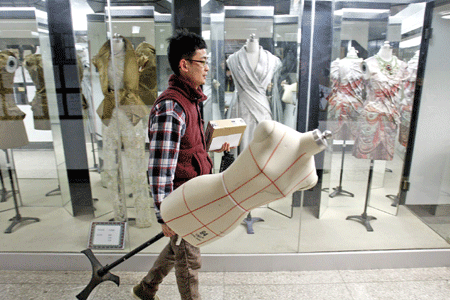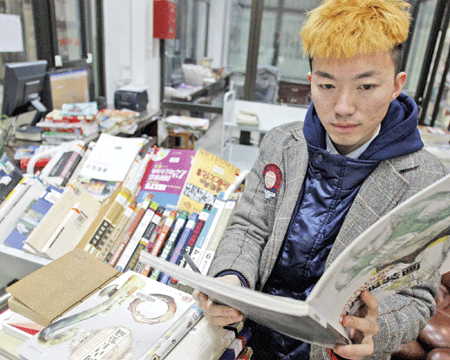Fashionably young
Updated: 2012-01-10 08:13
By Gan Tian (China Daily)
|
|||||||||||
|
|
|
|
|
|
A new generation of designers are building on the foundations laid by the first crop of New China's designers in the 1980s. Gan Tian reports.
Zheng Rong passed the National Higher Education Entrance Examinations in 1987, after which she chose to major in fashion design, a new subject offered by Beijing Institute of Fashion Technology (BIFT) that year.
She clearly remembers her neighbor's reaction: "You studied so hard to pass the exams and now you want to be a tailor?"
Zheng explains: "At that time, Chinese people did not have much of an idea of fashion and what a fashion designer does."
But Zheng and her classmates had a lot of fun and took full advantage of the opportunities provided by the institute.
She recalls the classroom was set up like a small fashion company. Every student had a cubicle, where they learned to paint sketches and cut cloth.
"The sewing machines were very old-fashioned. We had to use a pedal-driven sewing machine," Zheng says.
She and her classmates spent a lot of time going to a cloth market in Xinjiekou on Beijing's Second North Ring Road to find cheap materials.
As a sophomore, Zheng finished her first garment - a simple black, short skirt. It was the '90s, and short skirts were just coming into fashion. Every girl wanted one, Zheng says.
At the time, BIFT (known then as the Beijing Textile Engineering Institute) specialized in technology. So it primarily enrolled students who had majored in science during high school.
Zheng says she and her classmates - all skilled at mathematics, physics and chemistry - had difficulty coming up with fashionable or arty ideas.
She read a lot of books about architecture, style and art history in her spare time.
Instead of becoming fashion designers, however, most of Zheng's classmates chose to work as teachers or editors at publishing houses.
Twenty years later, things are totally different.
For example, fashion design major Li Linchuan will graduate next month.
He looks like a fashion designer. He has dyed his hair gold and wears an oversized coat from his own label. He often carries an easel and mannequin around with him on campus. Li creates garments at night and sleeps during the day.
Currently, there are more than 1,400 students at the School of Fashion Art and Engineering of BIFT. At night, the sixth floor of the school's main building is always lit up, as Li and his classmates make garments there.
The classrooms are equipped with advanced sewing machines, and there are regular shows for BIFT students to showcase their creations.
Li produced three collections of more than 50 garments during his four-year course. He has stored them at a boutique in Beijing's Jianwai SOHO.
Unlike Zheng, Li tends to use bold colors and styles. An exaggerated silver overcoat Li created at the end of 2011 was inspired by Rei Kawakubo. Two of these overcoats were bought for more than 6,000 yuan ($944).
The sales have given Li confidence, and he says he will certainly start his own label after he graduates.
Attending the fashion weeks of Milan and London are on Li's to-do list. He went to Amsterdam to attend a three-month design project in 2011 and says he was impressed by how much attention is paid to fashion design there.
He says he is lucky to be in an environment like BIFT where young designers like him can grow, inspired by people like Zheng, who is now Li's teacher.
Today's Top News
Rescuers race against time for quake victims
Telecom workers restore links
Coal mine blast kills 18 in Jilin
Intl scholarship puts China on the map
More bird flu patients discharged
Gold loses sheen, but still a safe bet
US 'turns blind eye to human rights'
Telecom workers restore links
Hot Topics
Lunar probe , China growth forecasts, Emission rules get tougher, China seen through 'colored lens', International board,
Editor's Picks

|

|

|

|

|

|








